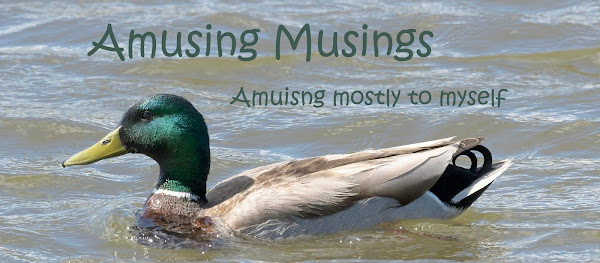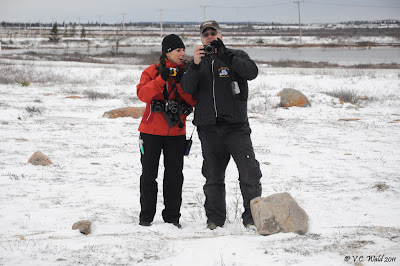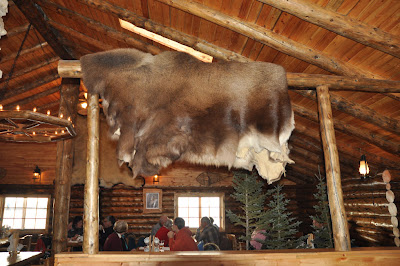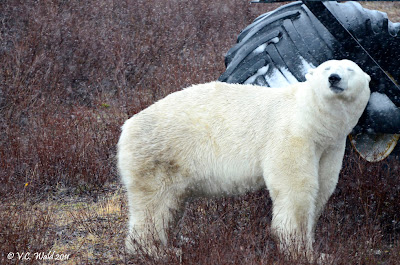The United Airlines direct flight from Chicago to Winnipeg (aka, Winterpeg, and Windypeg, though you wouldn't know it from our couple of beautiful days there), jumping off city for Churchill and polar bears, is surprisingly easy from Chicago. Although from the perspective of that other Windy City, the one at the nadir of Lake Michigan, Winnipeg seems as though it should be much farther, in fact flying time is under two hours. We arrived in plenty of time to be summarily delivered by Natural Habitat Adventures to our hotel, the Fort Garry, dump our stuff, and head out to spend the afternoon with our friend, photographer Doug Dance, whose home Winnipeg is. I know him from years of travels to Yellowstone.
Doug has a day job but lives for weekends when he can get out of town with camera rigged for serious nature photography. In 2003, the year this photo of us was taken at Floating Island Lake, he had taken a year off from that day job to spend 365 days, 24/7, in Yellowstone The result was his wonderful first volume, Once Around the Sun in Yellowstone. Doug is the most accurate observer of wildlife, weather, seasons, and the impact of human beings on natural processes that I know, and his device of following selected sagas--especially the soap opera that is the lives of Yellowstone's wild wolves--is brilliant. What a treat that, on the beautiful mid-October day of our arrival, he took us out to Oak Hammock Marsh, a favorite birding spot less than a hour's drive from the center of the prairie city that is Winnipeg. We were a little early for snow geese, a little late for many other winged migrants, but just in time for loads of Canada geese, and a dozen northern harrier sightings as they worked the stubbled fields along the way. The major thing we learned from this lovely afternoon is that Manitoba, the population of which is in any sense dense only in the southern fourth of its geography, is resplendent with natural beauty and an abundant variety of major wildlife, much of it within a few hours drive time from Winnipeg, making "The Peg" a fine place to live for a nature-lover.
 |
| KLK and Doug looking for a rare bird, or even a common one, Oak Hammock Marsh |
 |
| Please click to enlarge for detail. |
...which parallels the visually friendly Provencher Bridge for vehicular traffic, and beyond that (not visible in this photo), the railroad bridge:
Just under construction at the Forks is the Canadian Museum for Human Rights. It's going to be an architectural destination if nothing else when it's done.
Another of Winnipeg's claims to fame is that it is extraordinarily multicultural, in large part due to its stable economy and good job market; the Human Rights Museum will doubtless hold much meaning to locals as well as visitors.
Also at the Forks, a little indoor shopping area with some nice restaurants and most appealing sculptures outdoors:
 |
| The Wisdom Owl, artist unknown |
Over the years, I've checked out the lobbies of, or stayed in, a number of historic hotels built in late 19th and early 20th century by Canadian railroads, including the Chateau Frontenac in Quebec, the Prince of Wales in Waterton, Banff Springs in Banff, the Chateau Lake Louise in Jasper, the Empress in Victoria, and the Hotel Vancouver in Vancouver. Winnipeg's Fort Garry (opened in 1913), was built within a block of the railroad station, and is still a thriving concern nearly 100 years later. It has its charms, though I would not say it is quite up to the standard of your average 21st century hotel, nor does it rank up there with the Canada's top historic railroad hostelry for charm or elegance. The rooms are small (we stayed in two of them, one going and one coming, with four nights in Churchill in between), lined with feminine rose-print wallpaper, furnished "granny" style, with big old cathode ray tube TVs (I haven't been in any sort of hotel room, including the ill-fated Northern Nights in Churchill, that didn't have a flat screen TV, in years), and sun-stained green velveteen drapes. Perhaps being a conveniently-located historic edifice with reliable contracts with tour companies makes the existence of competition moot!
In any case, we ended our stay in Canada with a good night's sleep, and on the flight home caught one last good look at how this lovely city sits surrounded by rich productive agricultural land, the fruits of which keep the port of Churchill busy.
X



























































